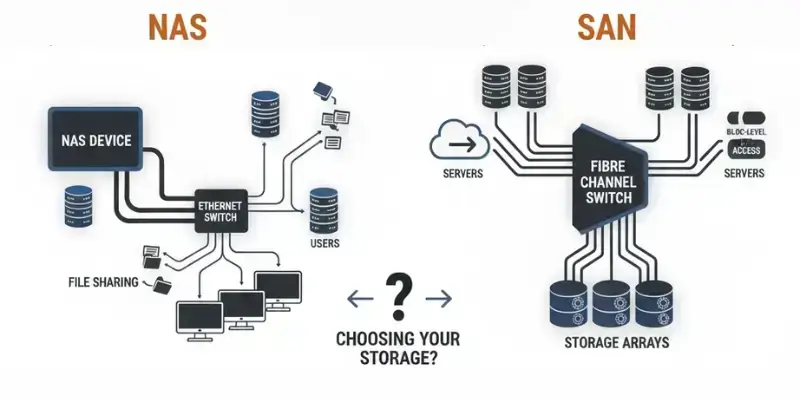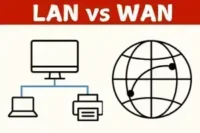NAS Storage vs SAN Storage: Key Differences Explained Simply
Published: October 16, 2025
Confused between NAS and SAN storage? You’re not alone. Both are innovative ways to store and manage data, but each has pros and cons. NAS (Network Attached Storage) is easy to set up and perfect for file sharing—but it can slow down when too many users access it simultaneously. SAN (Storage Area Network) offers faster, more reliable performance—but it’s expensive and harder to manage. That’s why many people struggle to choose between them. This guide’ll explore how each system works, where they shine, and where they fall short. By the end, you’ll know which storage option is smarter.

Definitions of NAS and SAN Storage
NAS (Network Attached Storage)
NAS is a storage device that connects to your network so everyone can easily share and access files. It’s simple to set up and works well for homes or small offices where many users need to store and use the same data.
SAN (Storage Area Network)
SAN is a faster and more powerful storage setup that links servers and storage devices through a special network. It’s mainly used by large companies or data centers that need high speed, large capacity, and reliable performance for heavy tasks.
NAS vs SAN Storage: Key Differences
| Aspect | NAS (Network Attached Storage) | SAN (Storage Area Network) |
| 1. Full Form | Network Attached Storage | Storage Area Network |
| 2. Storage Type | File-level storage | Block-level storage |
| 3. Network Connection | Uses LAN (Ethernet) | Uses Fibre Channel or iSCSI |
| 4. Installation | Simple plug-and-play setup | Complex installation and configuration |
| 5. Speed | Moderate speed | Extremely fast performance |
| 6. Cost | Budget-friendly | High setup and maintenance cost |
| 7. Scalability | Easy to expand for small setups | Designed for large-scale growth |
| 8. Best Suited For | Homes and small offices | Enterprises and data centers |
| 9. File Access | Accessed like a shared folder | Appears as a local disk to servers |
| 10. Protocols Used | NFS, SMB, or CIFS | iSCSI or Fibre Channel |
| 11. Performance Under Load | May slow down with multiple users | Handles heavy workloads smoothly |
| 12. Management | Easy file management | Centralized and advanced storage management |
| 13. Reliability | Moderate reliability | High fault tolerance and uptime |
| 14. Maintenance Needs | Low maintenance | Requires skilled IT staff |
| 15. Backup & Recovery | Basic options | Advanced recovery and redundancy systems |
| 16. Security | Standard network security | Enterprise-grade data protection |
| 17. Common Uses | File sharing, backups, media storage | Databases, virtualization, critical apps |
NAS vs SAN Storage: What’s the Real Difference?
You’re not alone if you’ve ever wondered what separates NAS from SAN. Both are used for storing and sharing data, but they’re built for different needs. Let’s walk through the differences in plain language.
1. Ease of Use
NAS keeps things simple. You plug it in, open a browser, and it’s ready. Even someone running a small business with no tech background can get it working without much help.
SAN, on the other hand, is more technical. Setting it up usually means dealing with fibre channel or iSCSI connections, which is not beginner-friendly. It’s built with IT pros in mind.
So if you just want storage that works right out of the box, NAS is easier. SAN gives you more options if you like control and don’t mind getting your hands dirty.
2. Features
Both offer solid tools, but they’re aimed at different kinds of users.
NAS is made for file sharing, media streaming, and simple backups. It’s great for small teams that need a central spot for their files.
SAN takes it up with features like fast data transfers, redundancy, and support for virtualization or large databases. It’s built for companies that move a lot of data and need constant uptime.
In short, NAS covers everyday storage needs, while SAN handles heavy-duty, enterprise-level work.
3. Performance
Here’s where the difference really shows.
NAS runs on your regular network connection (like Ethernet). It’s fast enough for office work, but performance can dip if too many people use it simultaneously.
SAN uses dedicated high-speed connections, so it’s built for speed. Even under pressure, it keeps data flowing smoothly.
If your work depends on top-tier speed and low latency, SAN wins. For everyday use, NAS still does the job just fine.
4. Pricing
Money matters, right?
NAS is much easier on the budget. You can start with a modest setup covering most small to mid-size business needs.
SAN costs a lot more. It needs specialized hardware and a team that knows how to manage it. There’s also ongoing maintenance, which adds up.
So if you want value and simplicity, go with NAS. If performance is worth the extra investment, SAN makes sense.
5. Scalability
Think of scalability as how well your storage grows with you.
With NAS, you can add more drives or devices pretty easily. But as your network expands, things might slow down a bit.
SAN is designed for growth. You can keep adding capacity without losing speed or performance, which makes it ideal for companies that plan to scale big over time.
In short, NAS works well for smaller growth, while SAN handles long-term expansion.
6. Security
Both systems can be secure, depending on how they’re managed.
NAS usually offers standard file permissions and encryption. It’s fine for most offices, but connecting it directly to a public network can be vulnerable.
SAN gives you stronger protection options like access control, zoning, and encryption at multiple levels. It’s what larger organizations rely on to keep sensitive data safe.
So while NAS is secure enough for everyday use, SAN offers deeper layers of protection.
7. Support and Maintenance
If you want something low-maintenance, NAS is the easier option. Most models come with online guides and easy firmware updates.
SAN setups need trained IT staff for troubleshooting and regular updates. Vendors often provide professional support, but it’s another cost.
So for quick fixes and simple upkeep, NAS wins. If you need enterprise-level support, SAN’s your pick.
Similarities Between LAN and WLAN
LAN and WLAN sound different because one uses cables and the other is wireless, but they work in many of the same ways.
1. Same Goal
Both help you connect computers, phones, and printers in one place, like an office, school, or home.
2. Easy Sharing
You can share files, the internet, and even printers on both networks without plugging everything into one device.
3. Small Coverage Area
LAN and WLAN both cover a limited area. They’re meant for one building or campus, not long distances.
4. Your Own Network
You set them up yourself or through your team, which means you control how it runs and who joins.
5. Similar Equipment
Both use routers, switches, or access points to connect everything smoothly.
6. Same Communication Rules
They follow the same basic internet language (like TCP/IP) so devices can talk to each other easily.
7. Data Protection
You can add passwords, firewalls, and encryption to keep your files safe.
Final Verdict: NAS vs SAN Storage
NAS and SAN store data, but fit different kinds of users.
NAS (Network Attached Storage) is great for beginners, small offices, or home setups. It’s simple to install, easy to use, and budget-friendly. You can share files, save backups, or stream media without an IT expert.
SAN (Storage Area Network) is built for big teams and advanced users. It’s fast, powerful, and can handle vast amounts of data. But it needs proper setup, planning, and technical skills to run smoothly.
If you just want something easy and affordable, go for a NAS.
SAN is the way to go if you need top speed and heavy data handling.
Take a moment to think about what you need—simplicity or performance—and pick the best one that fits your setup.
FAQ About NAS vs. SAN Storage
The primary difference lies in how they store and access data. NAS works with files, while SAN works with data blocks. NAS connects through a standard network, and SAN utilizes a specialized high-speed network for enhanced performance.
NAS is better for small businesses. It’s easy to install, doesn’t need expert help, and costs less. You can use it for file sharing, data backup, or media storage.
Big companies choose SAN because it’s fast, reliable, and designed for high-volume data usage. It keeps large databases, virtual machines, and servers running smoothly without slowing down.
Yes, they can! Some setups mix NAS and SAN to get the best of both—NAS for easy file sharing and SAN for high-speed performance. It depends on your system’s needs.
Yes, NAS is secure for small offices if you use passwords, firewalls, and encryption. But for highly sensitive data, SAN offers stronger protection and access control.
NAS is easier to maintain. It requires minimal technical work and comes with straightforward software updates. SAN, however, requires trained IT staff for setup and maintenance.
Yes, SAN is more expensive. It needs special hardware, cables, and management tools. NAS is budget-friendly and great for beginners or small teams.
Absolutely! NAS works great for storing games, movies, and music. You can access your files anytime without filling up your PC or console storage.
Absolutely! NAS works great for storing games, movies, and music. You can access your files anytime without filling up your PC or console storage.
Both have backup options. NAS typically offers basic backup, while SAN includes advanced recovery systems that protect your data even in the event of hardware failure.
Ask yourself what you need most. If you’re looking for something simple and affordable, consider a NAS. If you need speed, reliability, and room to grow, SAN is the smarter pick.
You May Also Like These Posts
What are the Advantages and Disadvantages of Storage Area Network(SAN)?
Personal Area Network Uses (PAN): Our Daily Network
What are the Advantages and Disadvantages of Wired and Wireless Networks?
Backbone cabling vs Horizontal cabling
What is a Local Area Network Router?
Learn How Metropolitan Area Network Topologies Work
What Is a Personal Area Network PAN? Explained with Examples
Personal Area Network Security: How to Keep Your Devices Safe
WLAN vs LAN: Complete Guide to Understand Two Network Types





